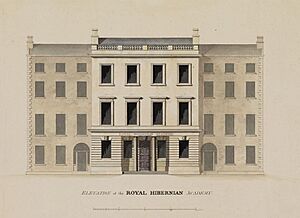Royal Hibernian Academy facts for kids
| An tAcadamh Ibeirneach Ríoga | |
 |
|
| Lua error in Module:Location_map at line 420: attempt to index field 'wikibase' (a nil value). | |
| Established | 5 August 1823 |
|---|---|
| Location | 15 Ely Place, Dublin, Ireland |
| Type | Art gallery, Art studios |
| Public transit access | |
The Royal Hibernian Academy of Arts (RHA) is a special place for artists in Ireland. It was started by artists, for artists, in Dublin in 1823. Even after most of Ireland became independent in 1922, the Academy kept the word "Royal" in its name.
Contents
The RHA's Story: A Look Back
How the RHA Began
The RHA started because 30 Irish artists wanted a special group to support art. They asked the government for official permission. On August 5, 1823, the Royal Hibernian Academy of Painting, Sculpture, and Architecture was officially created. It even included a National School of Art!
The first president was a landscape painter named William Ashford. In 1824, the architect Francis Johnston became president. He even gave the RHA its first home, called Academy House, on Lower Abbey Street. He paid for it himself!
Early Art Shows and Growth
The first art shows happened in May 1825. After that, they were held every year. To get more people interested in art, some artworks were given away as prizes. People who supported the RHA could win pieces by famous artists. These included works by J. M. W. Turner and Frederick William Burton.
By the end of the 1800s, the RHA was the most important group in Ireland for showing and promoting visual arts.
A Big Loss: The 1916 Fire
In 1916, during the Easter Rising, Academy House was destroyed by fire. Most of the RHA's art collection was lost too. More than 500 artworks, including pieces by Jack Butler Yeats, were gone forever.
For 69 years, the RHA did not have its own building for exhibitions. But they still managed to hold their annual art shows.
Embracing New Art Styles
In 1943, a new group called the Irish Exhibition of Living Art (IELA) started. They felt the RHA was too old-fashioned and not open enough to modern art. However, things changed over time. One of the IELA founders, Louis le Brocquy, later became an honorary member of the RHA. Today, the RHA welcomes both modern and traditional art.
A New Home in Ely Place
In the 1970s, the RHA built a new home in Ely Place in Dublin. This building replaced an older Victorian house. A builder named Matt Gallagher agreed to build a modern gallery for the RHA. Sadly, he passed away suddenly in 1974 before it was finished.
The building was unfinished for several years. Eventually, it was completed and became the RHA's new home. It has six galleries where the annual exhibition is held. The Academy also puts on many other art shows. Sometimes they show a large collection of works by one Irish artist. The RHA has a big collection of Irish art, but it is not usually on display.
The building was closed for updates between 2007 and 2009.
Learning Art at the RHA
In 2009, the RHA reopened its art school, called the RHA Drawing School. It has a large drawing studio and six other studios for artists to use. The school also manages other studios, like one in Kilkenny.
The school offers courses in painting and drawing techniques. These courses are taught by members of the Academy and other artists. Students can learn from talented tutors like Colin Martin RHA and Mick O'Dea PPRHA. The school also hosts workshops with artists from around the world.
How the RHA is Supported
The Academy gets its money from a few places. The Arts Council helps fund them. They also earn money from their annual art show. Many generous people, called benefactors and patrons, also support the RHA.
Exciting Art Shows
The Annual Exhibition
The RHA has held an annual exhibition every year since 1826. Artists can submit their work to be shown. It is the biggest and longest-running art show in Ireland!
FUTURES: Spotlighting New Artists
FUTURES is a special series of exhibitions. It shows the work of new and upcoming artists from Ireland. It started in 2001 and has had many shows. Each series also has a final show that brings all the featured artists together.
Becoming a Member
The RHA has different types of members. Full members can use "RHA" after their name. Associate members use "ARHA," and Honorary Council members use "HRHA."
See also
 In Spanish: Royal Hibernian Academy para niños
In Spanish: Royal Hibernian Academy para niños
- Irish art


